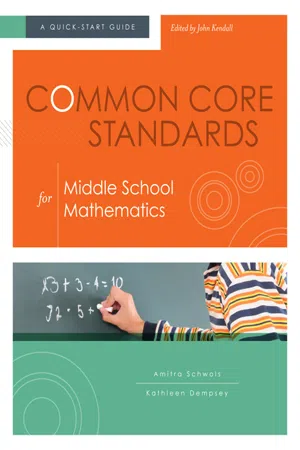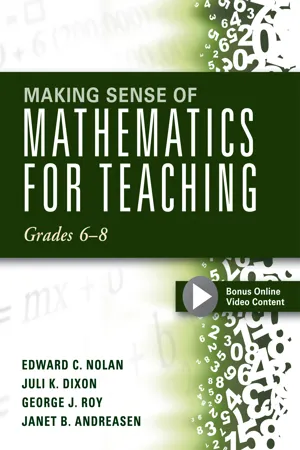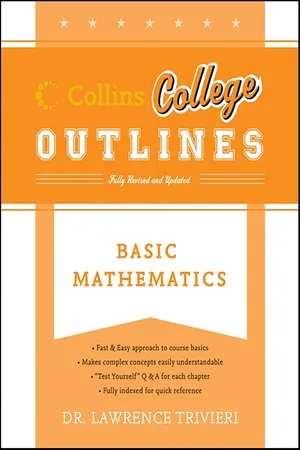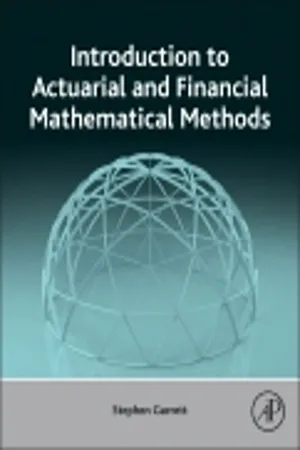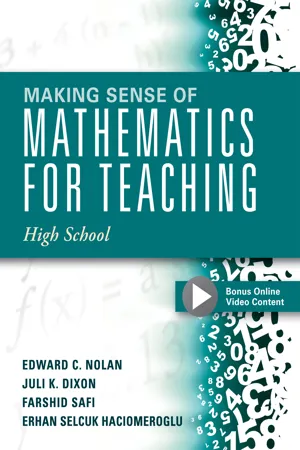Mathematics
Equations
Equations are mathematical statements that assert the equality of two expressions. They typically contain variables, constants, and mathematical operations. Solving an equation involves finding the values of the variables that make the equation true. Equations are fundamental in various mathematical fields, including algebra, calculus, and physics, and are used to model and solve real-world problems.
Written by Perlego with AI-assistance
Related key terms
8 Key excerpts on "Equations"
- eBook - ePub
Common Core Standards for Middle School Mathematics
A Quick-Start Guide
- Amitra Schwols, Kathleen Dempsey, John Kendall, John Kendall(Authors)
- 2013(Publication Date)
- ASCD(Publisher)
Chapter 4Expressions and Equations
. . . . . . . . . . . . . . . . . . . .The introduction to the Common Core standards' high school Algebra domain provides some useful definitions to help differentiate the two mathematical terms expression and equation:An expression is a record of a computation with numbers, symbols that represent numbers, arithmetic operations, exponentiation, and, at more advanced levels, the operation of evaluating a function…. An equation is a statement of equality between two expressions, often viewed as a question asking for which values of the variables the expressions on either side are in fact equal. These values are the solutions to the equation. (CCSSI, 2010c, p. 62)The middle school Expressions and Equations (EE) domain provides a critical bridge between content in the Operations and Algebraic Thinking domain in earlier grades and algebraic content students will encounter in high school. Figure 4.1 shows an overview of the Expressions and Equations domain's clusters and standards by grade level. - eBook - ePub
- Toby Wagner(Author)
- 2021(Publication Date)
- Chemeketa Press(Publisher)
At the end of this section, we will write and solve an equation to find the width of the rectangle in the problem above. In the meantime, let’s learn more about Equations.A. Types of Equations
Anequationis a mathematical sentence that asserts that two things are the same or equal. An equals sign (=) means “is the same as.” It’s important, though, to understand that an equation only asserts that two things are the same. As you’ll soon see, this doesn’t guarantee that the statement is actually true.Some Equations are always true. These Equations are calledidentities. Identities are Equations that are true for all acceptable values of the variable. Here are some examples of identities:
About Acceptable Values5x = 5xis true for all acceptable values of x because 5 times any number is always the same as 5 times that same number.y + 1 = y + 1is true for all acceptable values of y because any number plus 1 is always the same as that same number plus 1.2 + 5 = 7 is true, and no substitutions are necessary because this equation doesn’t use any variables. For the Equations in the first few chapters of this book, the variables can be replaced with any real number. All real numbers are therefore acceptable values of the variable. Later, you will see Equations with more complicated expressions in which some numbers will not be used to replace the variable.Some Equations are never true. These Equations are called contradictions. Contradictions are Equations in which the expression on the left side and the expression on the right side are never equal, no matter what value is substituted for the variable.x = x + 1is never true for any acceptable value of x because no real number is equal to itself plus 1.0 · k = 14is never true for any acceptable value of k because the product of 0 and any real number is always 0. It can never be 14.2 = 1 is never true because 2 can never equal 1. The truth of some Equations depends upon the number value chosen for the variable. These Equations are calledconditional Equations - eBook - ePub
Well Played, Grades 6-8
Building Mathematical Thinking Through Number and Algebraic Games and Puzzles
- Linda Dacey, Karen Gartland, Jayne Bamford Lynch(Authors)
- 2023(Publication Date)
- Routledge(Publisher)
Chapter 5 Expressions and EquationsDOI: 10.4324/9781032683027-5What's the Math?
The study of expressions and Equations helps students to transition from their work with number and operations in elementary school to the level of conceptual understanding needed for algebra. Previously, students have applied the properties of operations to rational numbers; now, they apply these ideas to variables. Success in this area is essential for later achievement in high school mathematics and in solving real-world problems. The National Research Council defines two key features of algebra as “(a) a systematic way of expressing generality and abstraction including algebra as generalized arithmetic and (b) a guided transformation of symbols such as we do when we solve Equations by collecting like terms and using inverse operations” (NRC 2001 , 256).As students work with expressions and Equations, there is ample opportunity for them to reason quantitatively and abstractly as well as to construct and understand viable arguments. Attention to justification helps students to connect prior knowledge about numbers to that of variables. According to Michael Cioe and his coauthors (2015), justification goes well beyond students showing their work, as it involves why, not just how. Playing and solving these puzzles and games in teams requires students to justify their thinking and to analyze the thinking of others.In sixth grade, students read, write, and evaluate expressions, and translate an expression such as 6 less than x to x – 6. Students use the properties of operations to recognize and generate equivalent expressions and to solve one-step Equations and inequalities. They apply these ideas to the solution of real-world problems. In seventh grade, students extend these concepts and skills to the inclusion of rational numbers and the solution of multistep, real-world problems with positive and negative rational numbers. Students at this grade level also use mental computation and estimation strategies to assess the reasonableness of answers. In eighth grade, students solve linear Equations efficiently and solve systems of linear Equations with two variables. Students also make connections with other units of study as they use Equations to express proportional relationships and apply their knowledge of functions in the interpretation of linear relationships (Gartland 2014 - eBook - ePub
Making Sense of Mathematics for Teaching Grades 6-8
(Unifying Topics for an Understanding of Functions, Statistics, and Probability)
- Edward C. Nolan, Juli K. Dixon(Authors)
- 2016(Publication Date)
- Solution Tree Press(Publisher)
Much of the focus of the content of expressions, Equations, and inequalities in the middle grades provides the groundwork for understanding algebra. As students make sense of real-world situations with unknown quantities that do and do not vary, they engage in algebraic reasoning. Students learn to write and solve expressions, Equations, and inequalities, using context to help make sense of the language and structure of mathematics. Students in grades 6–8 must be able to write expressions and Equations from context, solve Equations and inequalities, investigate the concept of slope, and solve systems of Equations.Writing Expressions and Equations From Context
In language, an expression communicates an idea. The same can be said for algebraic expressions—they communicate what contexts represent. Interpreting context lays a foundation for making sense of algebra. Consider the task provided in figure 3.7 .Figure 3.7: The pencils and highlighters task.You are cleaning out your desk at school. You find that you have 6 times as many pencils as highlighters. Write an equation for the number of pencils (p ) in terms of the number of highlighters (h ).How did you set up your equation? When posed with this task, many people write the equation 6p = h . How can you test this equation to see if it matches the context? When you start to substitute numbers for the variables in the equation 6p = h , what do you notice? If you let p equal 12, then h is 72. Does this make sense in the context of the problem? Returning to the context, you realize that there should be more pencils than highlighters, in fact, six times more. Instead of thinking about the relationship between the number of pencils and the number of highlighters, the equation 6p = h was written to follow the order of the items presented in the task; whereas, the equation 6h = p correctly represents the mathematical relationship. This is an important example of the need to combine the language of mathematics—and possibly the use of the key words - No longer available |Learn more
- Lawrence A. Trivieri(Author)
- 2011(Publication Date)
- Collins Reference(Publisher)
CHAPTER 11An Introduction to Algebra
I n this chapter, we introduce algebra as a generalization of arithmetic. In algebra, we use letters to represent numbers. Algebraic expressions are discussed, including evaluating and combining them. Removing symbols of grouping is also discussed. In addition, the language of algebra is introduced. Linear Equations in a single variable is also discussed, together with the applied problems they can help solve.11.1 EVALUATING ALGEBRAIC EXPRESSIONS In this section, you learn to classify algebraic expressions as sums or products and to evaluate an algebraic expression. ALGEBRAIC EXPRESSIONSIn algebra, letters are used to represent numbers. Such letters are called variables. The numbers are called constants. For example, in the expression × + 3y, the constant is 3; the variables are x and y . An algebraic expression is an expression that consists of constants and variables. Operation symbols and grouping symbols may also be included in the expression.The following are algebraic expressions:- x + y 2 + z3
- –2a +3bc
- 5m 3 – 3q5
- –7xyz
- u 3 –8u + u +
For our purposes, a difference is treated as an algebraic sum. Hence, x – y means x + (–y ). The expression 3u – 2v is called a sum of two terms, which are 3u and – 2v .- The algebraic expression 4t 2 – 3t can be written as 4t 2 + (–3t ). The constants are 4, 2, and –3; the variable is t
- The algebraic expression 3s 4 – 2s – 3 + can be written as 3s 4 + (–2s ) + (–3)
- The constants are 3, –2, and – 3; the variable is s .
In an algebraic expression, a term is part of a sum. Terms are separated by + or – signs. A factor is part of a product.Exercise 11.1Determine whether each of the following expressions is a sum or a product. If a sum, determine the number of terms; if a product, determine the number of factors. - eBook - ePub
Learning and Teaching Mathematics
An International Perspective
- Peter Bryant, Terezinha Nunes(Authors)
- 2016(Publication Date)
- Psychology Press(Publisher)
After setting up an equation to represent a problem situation, the next step is solving it. The techniques of equation solving are considered by many to be the core of algebra. Thus, considerably more research has been carried out in this area than in, say, learning to use the letters of algebra to express generality. (For a fuller treatment of the research literature on equation solving, see the algebra review by Kieran, 1992, as well as Wagner & Kieran, 1989.)There are two main classes of conceptual demands associated with solving Equations: simplifying expressions and dealing with equality-equivalence. The former demand has already been discussed in the section on Expressing Generality and will not be repeated here. When students learn to solve Equations, they must cope with two significantly different kinds of equality-equivalence: (a) one is the equality of left and right sides of each equation, which is signified by the equal sign and which means that for some value(s) of x the resulting values of both sides are the same (e.g. in the equation 1 + 5x + 3 = 2x + 7, the expression 1 + 5x + 3 is equal to the expression 2x + 7, when x has the value 1); and (b) the other is the equivalence of successive Equations in the equation-solving chain which is implicitly conveyed by the conventional, vertical, sequential layout of the Equations. This equivalence is obtained in two ways: (a) by the replacement of an expression by an equivalent expression (e.g. in 1 + 5x + 3 = 2x + 7 where the left-hand expression, 1 + 5x + 3, is replaced by the equivalent expression 5x + 4 in order to yield 5x + 4 = 2x + 7) or (b) by the replacement of an equation by an equivalent equation (i.e. one having the same solution) but not necessarily involving the replacement of an expression by an equivalent expression (e.g. 5x + 4 = 2x + 7 being replaced by 5x + 4 – 4 = 2x - Stephen Garrett(Author)
- 2015(Publication Date)
- Academic Press(Publisher)
.b.For all p and q in the set of negative real numbers, the product of p and q is in the set of positive real numbers. For example,− 10.6 , − 5.3 ∈, andR −56.18 ∈.R +c.There exists z in the set of integers such that z is less then 7 and is odd. For example, z = 5.d.For all p in the set of rational numbers, there exists q in the set of rational numbers such that 3p = q . For example, p = 4/3 and q = 4.1.3 Algebraic expressions
As we shall see throughout this book, mathematical methods require the manipulation of mathematical expressions. At this stage, it is important to define what we mean by the distinct types of mathematical expressions: Equations , identities , inequalities , and functions . The distinction between these terms is the topic of this section, and functions will be considered in detail in Chapter 2 .1.3.1 Equations and identities
The key distinction between an equation and an identity is the number of values of the independent variable (x in Eqs. 1.2 and 1.3 ) for which the expression is true. An identity is true for all values of the independent variable, but this is not true of an equation.Put another way, for an identity, it is possible to show that the expression on the left-hand side (LHS) of the equal sign is algebraically equal to that on the right-hand side (RHS). This is not true of an equation and one might be required to find the particular values of the independent variable for which the equality between the LHS and RHS holds. In general, an equation could have a finite or infinite number of values of the independent variable for which the equality holds; typically we might refer to these values of the independent variable as the solutions of the equation.Consider the following expression:= x + 10( x + 4 )2(1.2)It should be immediately clear that Eq. (1.2 ) is not an identity. In particular, we might note that the LHS is a quadratic expression, that is the highest power of x is 2, and the RHS is linear, that is the highest power of x is 1. For this reason the behavior of the LHS and the RHS will be very different as x takes different values. We return to a discussion of polynomials in Chapter 2- eBook - ePub
Making Sense of Mathematics for Teaching High School
Understanding How to Use Functions
- Edward C. Nolan, Juli K. Dixon, Farhsid Safi, Erhan Selcuk Haciomeroglu(Authors)
- 2016(Publication Date)
- Solution Tree Press(Publisher)
CHAPTER 1Equations and FunctionsWhat is the purpose of teaching functions in secondary mathematics? The concept of functions is one of the most important concepts in mathematics; it enables students to make connections within and across mathematical topics. Students need to understand patterns and the link to functional relationships, learning that mathematics is more than just manipulating algebraic expressions. As students use functions to represent relationships in multiple ways, they begin to recognize mathematical ideas in real-world situations and form notions of mathematical modeling (see chapters 5 and 6 for discussions on modeling). In order to emphasize the importance of exploring and connecting different types of functional relationships, different function types, such as linear and quadratic functions, and systems of linear Equations are explored through real-world situations in this chapter and in chapter 2 . Connections are made among verbal, numerical, graphical, and algebraic representations of mathematical concepts to illustrate the role and significance of multiple representations in understanding functions.The main goal of this chapter is to develop deep understandings of Equations and to examine the underlying equivalency of representations by modeling and predicting real-world phenomena. This is accomplished by providing an overview of the progression of early algebra learning and the notion of expressions, Equations, and variables, then defining and comparing linear and nonlinear functions in multiple representations.The ChallengeThe initial task in this chapter (see figure 1.1
Index pages curate the most relevant extracts from our library of academic textbooks. They’ve been created using an in-house natural language model (NLM), each adding context and meaning to key research topics.
